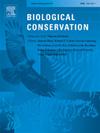Wind turbines displace bats from drinking sites
IF 4.9
1区 环境科学与生态学
Q1 BIODIVERSITY CONSERVATION
引用次数: 0
Abstract
Bats depend on water for drinking and foraging, but the increasing number of wind turbines may pose a problem for bats, as operating wind turbines are known to displace bats over long distances. We asked whether turbines displace bats from critical habitats, namely small ponds where bats drink and forage. We recorded the acoustic activity and foraging activity of three functional guilds of bats, i.e. open space, edge space and narrow space foraging bats, using automated detectors at 59 ponds located at varying distances (~50 to 5000 m) from wind turbines. We observed that edge space foraging bats were most abundant at focal ponds compared to narrow and open space foraging bats. The overall acoustic activity of open and narrow space foraging bats decreased with decreasing distance to wind turbines, whereas the activity of edge space foraging bats was unaffected by wind turbines. The feeding activity of bats at focal ponds decreased for open space foraging bats in proximity to wind turbines. For narrow space foraging bats, we observed a trend towards reduced feeding activity at ponds close to wind turbines, whereas we did not observe any effect of wind turbines on the feeding activity of edge space foraging bats. The siting of wind turbines close to drinking sites may degrade the resource landscape for bats, which could lead to population declines. Avoiding the proximity of turbines to important bat habitats is essential to protect biodiversity on farmland.
求助全文
约1分钟内获得全文
求助全文
来源期刊

Biological Conservation
环境科学-环境科学
CiteScore
10.20
自引率
3.40%
发文量
295
审稿时长
61 days
期刊介绍:
Biological Conservation is an international leading journal in the discipline of conservation biology. The journal publishes articles spanning a diverse range of fields that contribute to the biological, sociological, and economic dimensions of conservation and natural resource management. The primary aim of Biological Conservation is the publication of high-quality papers that advance the science and practice of conservation, or which demonstrate the application of conservation principles for natural resource management and policy. Therefore it will be of interest to a broad international readership.
 求助内容:
求助内容: 应助结果提醒方式:
应助结果提醒方式:


